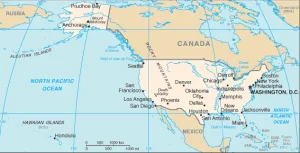Importing from the United States


US Country Profile
Official Name (Local Language) United States of America
Capital Washington, DC
Population 323,995,528
Currency US Dollar
GDP $18,560 billion
Languages English
Telephone Dial In 1
US Exports Profile
Exports ($m USD) 1,545,609
Number of Export Products 4,523
Number of Export Partners 224

USA Economic Statistics
Government Website | https://www.usa.gov/ |
| Sovereign Ratings | https://countryeconomy.com/ratings/usa |
| Central Bank | Board of Governors of the Federal Reserve |
| Currency USD Exchange Rate | |
| Unemployment Rate | 4.7% |
| Population below poverty line | 15.1% |
| Inflation Rate | 1.3% |
| Prime Lending Rate | 3.5% |
| GDP | $18,560 billion |
| GDP Pro Capita (PPP) | $57,300 |
| Currency Name | US Dollar |
| Currency Code | USD |
| World Bank Classification | High Income |
| Competitive Industrial Performance | 3/138 |
| Corruption Perceptions Index | 16/180 |
| Ease of Doing Business | 8/190 |
| Enabling Trade Index | 22/136 |
Access trade, receivables and supply chain finance
We assist companies to access trade and receivables finance through our relationships with 270+ banks, funds and alternative finance houses.
Get StartedImporting from USA
Listed as the second largest export economy in the world the United States is the eleventh most complex economy according to the Economic Complexity Index (ECI). On average in recent years the country has carried an annual negative trade balance of over $700 billion based on exports of $1.4 trillion and imports of more than $2.1 trillion annually. With a GDP per capita rate of more than $50,000 the average GDP rate is more than $16.5 trillion. With 20 international trading nations representing more than 75% of exports and 80% of imports – excluding services and foreign direct investment – the United States can be described as having a heavy concentration of trade activity with its favoured trading partners.
Importing from United States: What is trade finance?
In general, the United States has reduced its trade barriers and coordinates with others in the global economic system. Historically, the U.S. has taken the view that trade promotes economic growth, social stability, democracy and better international relations. However, President Donald Trump has called these principles into question: in early 2018 Trump declared that the U.S. will impose steep tariffs on steel and aluminum imports, causing escalating tensions with China and other trading partners and raising the prospect of higher prices for American consumers and companies. At the same time, further negotiations regarding a revision of the NAFTA agreement are being pursued. The U.S. is the world’s largest importer and second largest exporter of goods, as well as the largest importer and exporter of commercial services. Nevertheless, trade represents only around 27% of the country’s GDP.
Chart Showing GDP Growth Compared to rest of world
GDP Composition for USA
Agriculture
1.1%
Wheat, corn, other grains, fruits, vegetables, cotton; beef, pork, poultry, dairy products; fish; forest products
Industry
19.4%
Petroleum, steel, motor vehicles, aerospace, telecommunications, chemicals, electronics, food processing, consumer goods, lumber, mining
Services
79.5%
Map
Top 5 Exports Partners
| Country | Trade | % Partner Share |
| Canada | 282,243 | 27.11 |
| Mexico | 243,314 | 11.83 |
| China | 129,894 | 10.90 |
| Japan | 67,602 | 8.24 |
| United Kingdom | 56,244 | 5.07 |
Top 5 Exports Products
| Export Product | Number |
| Other medicaments of mixed or unmixed products, | 18.26% |
| Human and animal blood; microbial cultures; tox | 15.74% |
| Mixtures of odoriferous substances, for the foo | 8.4% |
| Compounds with pyrimidine or piperazine ring; n | 4.37% |
| Aircraft nes of an unladen weight exceeding 15, | 3.64% |
Local Authors
Local Partners
- All Topics
- United States Trade Resources
- Export Finance & ECA Topics
- Local Conferences

























